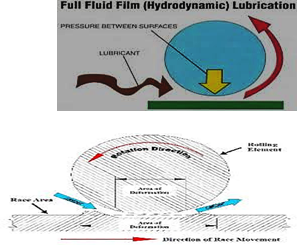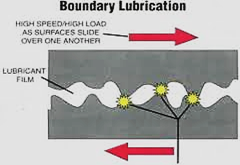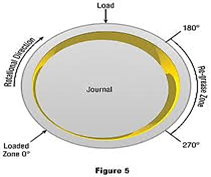←
Automobile Engineering
Different Types Of Lubrication
Introduction:
The process to reduce frictional force between the sliding and rubbing surfaces of metals is called lubrication.
Types of lubrication:
- Hydrodynamic lubrication:

- When this block is moved over the surface, a wedge-shaped oil film is built up between the moving block and the surface.
- This wedge-shaped film is thicker at the leading edge than at the rear.
- This type of lubrication where a wedge-shaped oil film is formed between two moving surfaces is called hydrodynamic lubrication.
- Elastohydrodynamic lubrication:
- When the load acting on the bearings is very high, the material itself deforms elastically against the pressure built up of the oil film.
- This type of lubrication, called elastohydrodynamic lubrication, occurs between cams and followers, gear teeth, and rolling bearings where the contact pressures are extremely high.
- Boundary lubrication:

- If the film thickness between the two surfaces in relative motion becomes so thin that formation of hydrodynamic oil film is not possible and the surface high spots or asperities penetrate called boundary lubrication.
- Such a situation may arise due to too high a load, too thin an oil or insufficient supply of oil due to low speed of movement.
- Most of the wear associated with friction occurs during boundary lubrication due to metal-to metal contact. A condition of boundary lubrication always exists when the engine is first started.
- The shaft is in contact with the bottom of the bearing with only a thin surface film of oil formed on them.
- The bearing surfaces are not perfectly smooth-they have ‘hills’ and ‘valleys’ which tear this thin film which is constantly formed while the crankshaft is turning slowly.
- As the speed increases it switches on to hydrodynamic lubrication. Boundary lubrication may also occur when the engine is under very high loads or when the oil supply to the bearing is insufficient.
- Bearing Lubrication:

- When the shaft is not rotating, there is metal-to-metal contact the shaft and bearing due to squeezing out of oil from under the journal because of shaft weight.
- As the shaft starts to rotate, due to high starting friction, the journal momentarily rolls slightly up the side wall.
- If some surface oil remains on the bearing the shaft will slide back to the bearing bottom when it hits the oil.
- This climbing and sliding back continues till sufficient oil is supplied by the pump so that the climbing shaft grabs the oil instead of the bearing wall and a curved wedge-shaped oil film is formed.
- This film now supports the shaft in the bearing. The only friction encountered is the small fluid friction caused by the rapid shear of the oil particles as they slip over one another.
- This phenomenon of shift from boundary lubrication to hydrodynamics lubrication is shown with the help of the relation between coefficient of friction μ and a dimensionless number ZN /P where Z is the oil viscosity, P is the pressure and N is the Speed. The coefficient of friction μ is minimum only at one value of ZN / P.
- The hydrodynamic pressure developed by the film is too low to lift the shaft and metal-to metal contact ensues.
- This is the zone of boundary lubrication. Reduction in viscosity or speed of increase in load (P), all move the operating point to left.